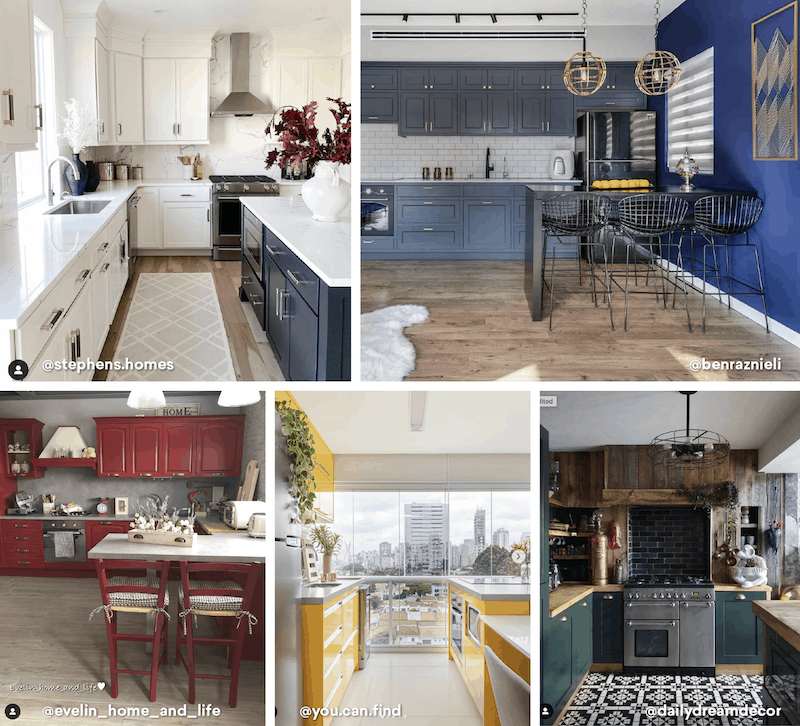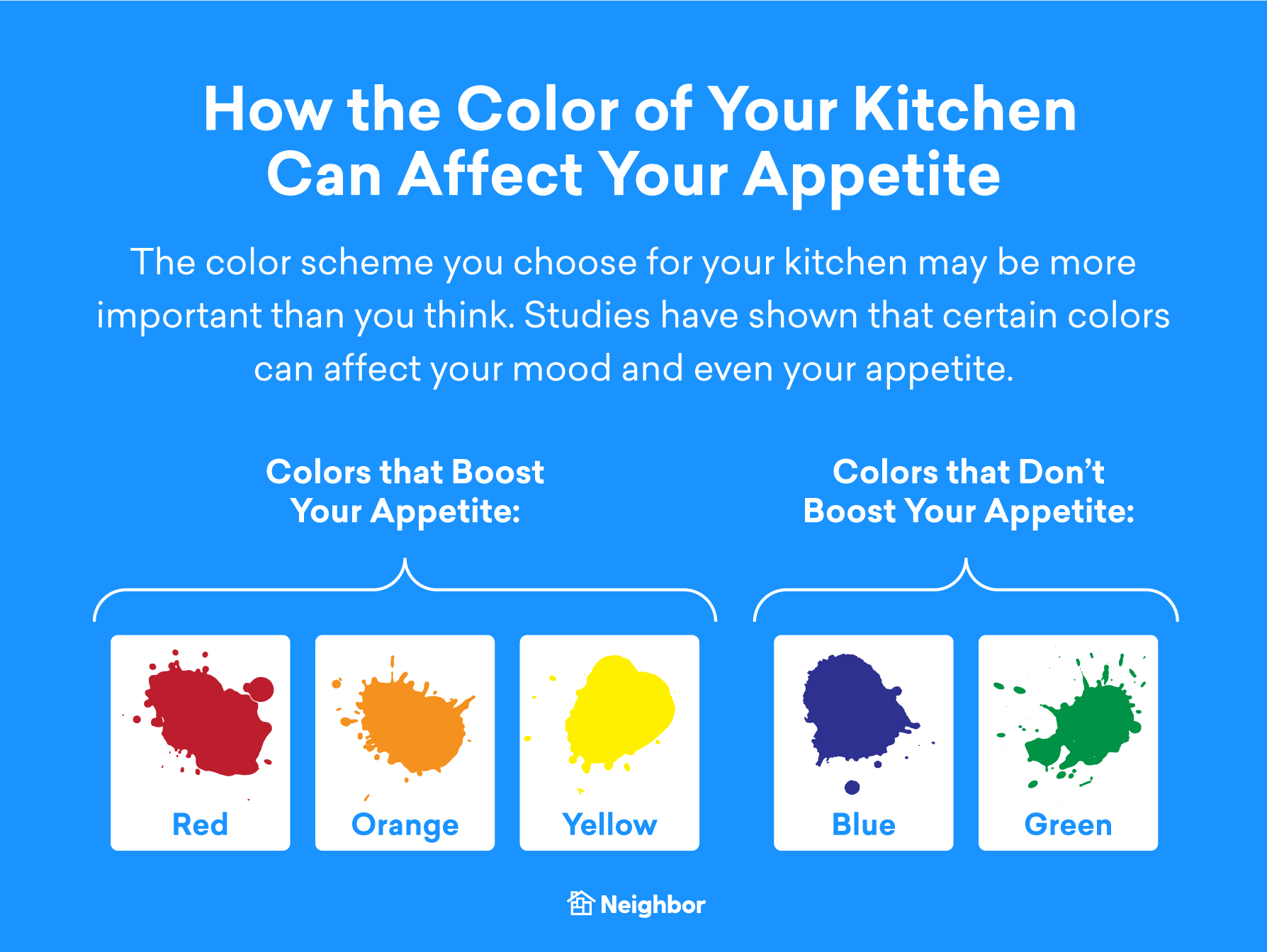When choosing your kitchen colors, what’s the right strategy?
Do you just pick some colors you like, and then hit the paint chip display at your local hardware store? Do you look for colors on sale to save a few bucks? They’re just paint colors — not exactly a high-stakes decision, right?
Well, not necessarily.
As it turns out, the colors you choose for your kitchen can be more impactful than you might ever have considered. Did you know that paint colors can affect us psychologically, impacting our sense of depth and space, our mood — even our appetite, making this choice all the more important when it comes to the kitchen?
It’s true, and we’re going to explain everything below. Before we get started though, a note: When choosing kitchen colors or any other colors for your home, you can take these psychology theories into account or ignore them and just choose colors you love. It’s your home, and it’s up to you. That said, though, the psychology behind paint colors is pretty fascinating, so let’s dive in.
How Psychology Can Play a Role In Choosing Kitchen Colors
Those who are experienced in interior design already know how much colors can change the way we’re influenced by spaces — and that goes for everywhere in our homes, not just the kitchen.
Bright and strong colors can add more life to a space, especially one that doesn’t get energy from natural light. Using colors and materials with little contrast can help a small space feel roomier. There are many, many examples of how designers use colors to influence how we perceive spaces.
So how can that help you decide on your kitchen colors? It really depends on your space and your goals. Here are a few psychology factors to keep in mind when shopping paint chips, wallpaper, tiles, and other color elements for your kitchen.
Color Affects Our Perception of Depth and Space
This will be especially useful for anyone who has a small cramped kitchen. Colors can trick the way our brains perceive a space in some really interesting ways.
You might have already heard that dark colors will make a space seem smaller and more closed-off, while light colors will brighten it and make it seem larger. That’s one of the oldest tricks in the interior design playbook.
But did you know that having contrasting colors will also make the space feel smaller? For that reason, if possible, you should choose your floor, counter, and cabinet colors to match the color you choose for the wall, if you’re trying to make your space look larger. For maximum effect, make everything a similar, light shade.
Color Affects Our Moods
Another well-known trick in interior design is choosing colors to evoke certain moods.
Here are just some of the most popular kitchen colors, and the feelings they tend to inspire:
- Red: Passion and energy. Seeing a red wall can raise your heart rate and give you more energy. But it’s also associated with anger and passion, which is why, in homes, you’re more likely to see a red accent wall than an entirely red room.
- Blue: Calm. Blue tones remind us of the ocean and the sky, and might make some people feel sleepy and relaxed. In hot climates, using blue tiles or ceramic in a kitchen can give the space a cooler feel.
- Green: Fresh and healthy. Green tends to remind us of plants and nature, which inspires feelings of harmony and balance. It also subconsciously makes us think of healthy, nutritious foods, which is why green is such a popular choice in kitchens.
- Yellow: Happiness and energy. It’s said that yellow stimulates the analytical part of our brains, but that it also suppresses creativity and may make some people feel uneasy. That’s why so many fast food restaurants have yellow walls: They want their customers to eat quickly and move on.
- White or gray: Maturity and security. White and gray are very trendy kitchen colors right now, which isn’t surprising considering they convey an air of class and success. A bright, white kitchen will feel open and clean, and gray accents can help provide the depth needed to keep the space from feeling too sterile.
Color Affects Our Appetite
One very surprising psychological factor you might consider when choosing kitchen colors is how colors can affect our appetite.
Ever wondered why so many restaurants use red tablecloths? Because red is an energizing color that evokes passion and can raise your heart rate, it can also increase your appetite. Restaurants are doing this to get their customers to eat more!
Red isn’t the only color that can affect how much you eat. Studies have shown that yellow and orange hues increase your brain’s serotonin production, which can also stimulate your appetite.
On the other hand, because they’re calming colors that tend to make people feel relaxed or sleepy, blue and green tones can actually have the opposite effect and suppress your appetite.
Factors to Consider When Choosing Kitchen Colors
The psychology aspects are fun to consider when choosing kitchen colors, but there’s a lot more you can take into account. These other factors can help you narrow down your choices to the perfect color for your space.
Keep Things Neutral
It can be tempting to choose a bright, trendy color, but neutrals tend to be more timeless and able to stand the test of time. If you want a kitchen that won’t look dated any time soon, sticking to neutrals can be a good strategy. Don’t forget, you can use dishes, towels, rugs, and other accessories to add pops of color.
Consider Your Lighting
The same color can look wildly different under different types of lighting. That’s why it’s very important to take your light into consideration when choosing colors for your kitchen. A kitchen with big windows and a lot of natural light might look nice in a darker shade that you wouldn’t want to use for an interior kitchen with harsh, LED lighting. Whatever colors you consider, make sure to test them in your actual space to see how they look with the lighting you have.
Mind Other Details in the Room
Maybe you’ve always dreamed of bright yellow kitchen walls, but your kitchen already has blue floor tiles and gray countertops. Or maybe you’d like a crisp, all-white kitchen, but you have to work with your home’s existing dark wood lintels.
All this to say, when choosing a color scheme, consider other parts of the room that you can’t change. Sure, flooring and counters can be replaced, but if you don’t have the time and budget for that kind of project, you might need to limit yourself to a paint color that complements what’s already there.
Mix Colors Carefully
There’s nothing wrong with mixing different color palettes in one room, but it’s important to make sure the finished product won’t be a clashing eyesore.
If you plan to use more than one bold color, gather all the elements you’re considering — flooring, countertops, cabinets, and paint — and see how they all look together in the space. Do this before installing anything, and don’t be afraid to change your mind if they clash too much.
How to Choose the Perfect Kitchen Color
Ready to get started and choose the perfect color for your kitchen? Use this checklist to make sure the color you end up with is just right for your space.
- Start thinking about colors you might like. Choose a variety of colors to explore, but not so many that you’ll have a hard time narrowing your choice down. 3-5 potential colors is a good starting point.
- Lay out samples of all the finishes going in your kitchen, if needed. This is only necessary if you’re building or renovating your kitchen from scratch. If floors, cabinets, and counters are already installed, then just lay out paint chips to see how they look against the other finishes, in your space, with the lighting you have.
- Use the process of elimination to remove colors one at a time until you have a decision.
- Use a tester can of paint to paint a small area of the kitchen in your chosen color. Take a break so you can see it with fresh eyes. Step back and really evaluate how it looks. Make sure you love it before you go ahead with painting the entire kitchen.
- Don’t be afraid to try another color if it doesn’t look quite right.
- Once you’ve decided for sure on a color you love, paint the whole room, and enjoy!
The kitchen is one of the most important rooms in a home, and the color scheme of the room can make or break it. By using this guide to choose the perfect color, you can make your kitchen into a place where you love to spend time preparing meals, being with family and friends, and enjoying a space that is truly your own.











